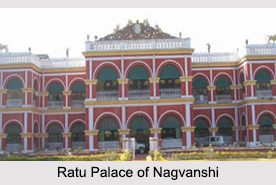 Jharkhand came into existence as an independent state in the year 2000. Prior to that, the area was part of the state of Bihar in India. Presently, Ranchi is the state capital of Jharkhand. The place has been inhabited by humans since Mesolithic-Chalcolithic and thus possesses a rich archeological and cultural history. Stone tools, cave paintings and arechelogical ruins of ancient monuments stands as a replica to the vast ancient history of the state.
Jharkhand came into existence as an independent state in the year 2000. Prior to that, the area was part of the state of Bihar in India. Presently, Ranchi is the state capital of Jharkhand. The place has been inhabited by humans since Mesolithic-Chalcolithic and thus possesses a rich archeological and cultural history. Stone tools, cave paintings and arechelogical ruins of ancient monuments stands as a replica to the vast ancient history of the state.
British identified this region as a great source of raw material for their booming industries back home and to exploit the region to its full potential, established a vast network of railway line. Calcutta was developed as a major port to export raw materials from this region to England.
Ancient history of Jharkhand
For a greater part of Vedic age, Jharkhand remained buried. During the age of Mahajanpadas around 500 BC, India saw the emergence of 16 large states that controlled the entire Indian subcontinent. The supremacy of the janpads was often decided by the power of swords, bows, axe and other weapons. The region around Jharkhand was extremely rich in its mineral resources including iron and the janpad that controlled this region, Magadha, eventually controlled most of the country. The power of Magadha continued to occupy central state in Indian subcontinent for a long time and saw the emergence of mighty empires such as Mauryas and Guptas.
After the end of last big Hindu empire of Guptas, India saw emergence of a number of numerous regional powers that tried to control this region. Same was the case with Muslim Sultans of Delhi and their feudatories in Bengal, who tried to control this mineral-rich area.
Medieval History of Jharkhand
 Birsa Munda from1875 to 1900 and Sidho and Kanho are the legendary heroes of the tribals of Jharkhand state who fought against the oppressive rule of the British government. Birsa Munda, now regarded as god, fought for the tribals natural right over forests and land that was mercilessly being acquired by the British for exploitation. After a long fight, Birsa Munda was captured by the British authorities and died in prison. Sidho and Kanho were another set of revolutionaries among the tribals, now regarded as tribal heroes. The region enshrouded in the hills and forests inaccessible to a large segment of people. The tribes of this state are living here from thousands of years and not much changed in their life and culture over the ages bearing last few decades.
Birsa Munda from1875 to 1900 and Sidho and Kanho are the legendary heroes of the tribals of Jharkhand state who fought against the oppressive rule of the British government. Birsa Munda, now regarded as god, fought for the tribals natural right over forests and land that was mercilessly being acquired by the British for exploitation. After a long fight, Birsa Munda was captured by the British authorities and died in prison. Sidho and Kanho were another set of revolutionaries among the tribals, now regarded as tribal heroes. The region enshrouded in the hills and forests inaccessible to a large segment of people. The tribes of this state are living here from thousands of years and not much changed in their life and culture over the ages bearing last few decades.
Many scholars now believe that the language used by tribes in the state of Jharkhand is identical to the one used by Harappan people. This has led to a great interest in the deciphering of Harappan inscriptions using rock paintings and language used by these tribes. In the last fifty years, the tribes of this region fought against the hegemony of Northern Bihar, a region that gained from the mineral deposits of this region like anything. Jharkhand became a state under the Republic of India on November 15, 2000 and now it is poised for a great leap forward.
Modern History of Jharkhand
For a long time, Jharkhand remained as a part of Bihar, but after Indian independence, the demand for a separate state of tribals started gaining momentum. The 28th state of the Indian Union was brought into existence by the Bihar reorganization Act on November 15,2000- the birth anniversary of the legendary Bhagwan Birsa Munda. Jharkhand is famous for its rich mineral resources like Uranium, Mica, Bauxite, Granite, Gold, Silver, Graphite, Magnetite, Dolomite, Fireclay, Quartz, Fieldspar, Coal (32% of India), Iron, Copper (25%of India) etc. Forests and woodlands occupy more than 29% of the state, which is amongst the highest in India. The industrial city of Ranchi is its Capital. Some of the other major cities and industrial centres are Jamshedpur, Bokaro Steel City, Sindri, Giridih, Gumla, Deoghar, Hazaribagh and Dhanbad once a part of West Bengal. Jharkhand is also popularly known as Vananchal vana plus anchal, meaning land of woods. Jharkhand is famous for its mineral wealth and forestry products.






